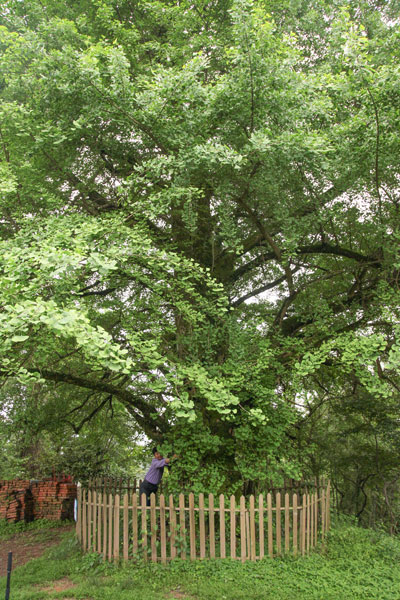 |
|
The old gingko tree on Panshan. Zhang Xiao /China Daily |
Meilin Temple, built by the monk Pan Shenghua in 1522, is nearly as difficult to reach as enlightenment. For now.
Few make the bone-juddering journey up the rutted dirt road that twists around the Panshan Mountains to reach the holy site - or what's left of it, anyway.
Just two structures remain of the once colossal compound that featured 36 courtyards and 300 houses built according to the style of ancient ethnic Hakka residences.
But Panshan's peak transforms during temple fairs, when thousands of devout Buddhists descend upon this place of pilgrimage tucked away in the wilderness.
The government of Jiangxi province's Huichang county plans to further develop the area to enhance its tourism offerings.
Those who hike along a tiny trail that clings to the cliff near Meilin can discover hidden gems in the forest.
Lore holds that a 1,300-year-old ginkgo tree here sprouted from the hairpin of one of Taoism's Eight Immortals, He Xiangu, who conspired to use it to assassinate Buddha.
Locals call it the "Maiden Hair Tree", because it is said that Buddha foiled He Xiangu's plot and poked the pin into the ground, where it took root and grew leaves.
Despite such a history of ancient antagonism between the two religions, the site today infuses Buddhism with Taoist elements.
A shrine that pious locals erected in the forest in 2009 hosts a Buddhist figure in the main hall and a trio of Taoist statues in the next.
Hikers must practically scramble over the ancient tombs of two monks, colonized by moss and vegetation.
They then reach a rocky outcrop where the woods fade away to offer views of the mountains that are truly breathtaking.
The location offers panoramas of the alpine range and the emerald Xiangshui River that loops 13 miles around the mountains' bases.
Huichang plans to integrate the waterway into its summer tourism festival. Visitors can hop aboard boats to take in views of the mountains rising above bursts of blooming flowers and disembark to stay overnight in Hakka farmhouses.
Yangjiao Water Castle is one of the main sites being developing along the river. The Ming Dynasty (1368-1644) settlement is being reincarnated as a creativity base, film site and tourism destination.
Villagers won't be relocated, and renovations will be minimal, the government says.
